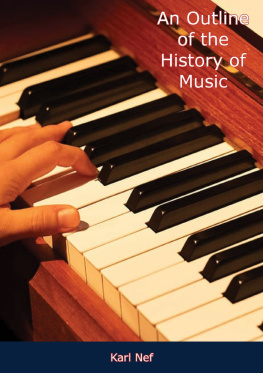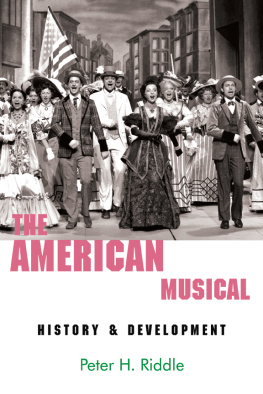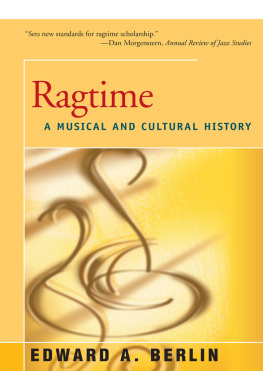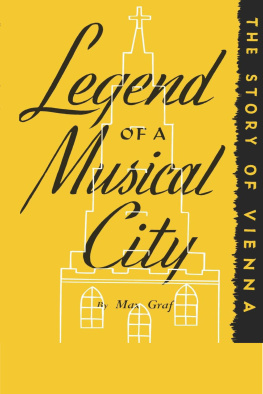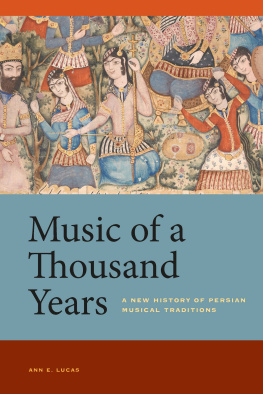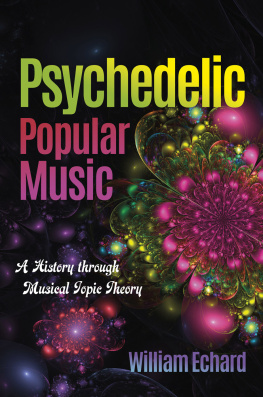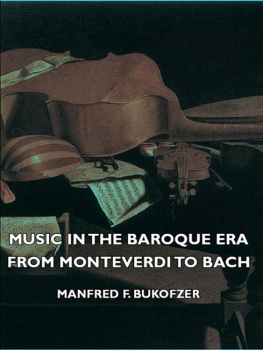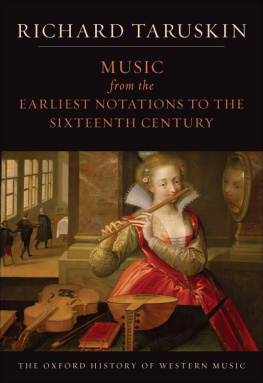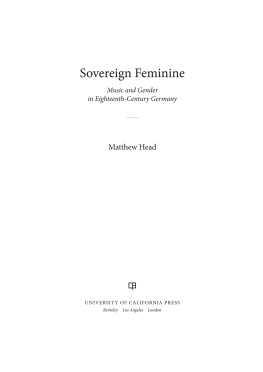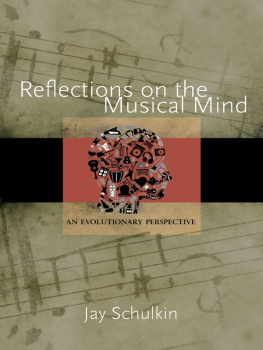

Barakaldo Books 2020, all rights reserved. No part of this publication may be reproduced, stored in a retrieval system or transmitted by any means, electrical, mechanical or otherwise without the written permission of the copyright holder.
Publishers Note
Although in most cases we have retained the Authors original spelling and grammar to authentically reproduce the work of the Author and the original intent of such material, some additional notes and clarifications have been added for the modern readers benefit.
We have also made every effort to include all maps and illustrations of the original edition the limitations of formatting do not allow of including larger maps, we will upload as many of these maps as possible.
AN OUTLINE OF THE HISTORY OF MUSIC
BY
KARL NEF
TABLE OF CONTENTS
Contents
INTRODUCTORY NOTE
The publication in America of a series entitled Studies in Musicology calls for comment. The very word musicology, used to denote the scientific, philosophic, and historic approach to the art of music, has only recently been added to the legitimate vocabulary of the English language. Although much has been written about music, a large part of this literature is purely technical, dealing with the theory of music and of composition from a practical point of view. Other books on music have been written from the standpoint of the artist dealing with his art. But the application to musical studies of purposive, systematic methods of research has been left to a comparatively small number of scholars.
Minute scholarly research in the field of music had been cultivated in Europe many years before signs of the same type of activity became evident in America. The time is ripe for the establishment of a series of musicological studies comparable to the various series which have been established in Europe. Our universities and colleges, our music schools and conservatories, are beginning to awaken to the fact that there is a place for musical scholarship in our system of education.
This series inaugurated by the Columbia University Press is intended to meet the needs of the English-speaking student for the crystallization of various phases of musical knowledge around which the rapidly expanding material may be oriented.
The choice of the first volume of the series was dictated by the desire to provide an introductory manual which would be of interest to the beginner in musical history, since a scholarly view of the development of the art must be the foundation of scholarly research into special problems. The Outline of the History of Music by the late Professor Nef of Basle is such a work. It was written by a trained musicologist of broad tastes, who was reliable in his judgments concerning recent developments in musical history and also of its early phases. It should be of real service to students as well as to general readers.
Other volumes in the series will be planned to include studies in more limited fields and of a more specific character.
Otto Kinkeldey
Cornell University,
Ithaca, N. Y.,
July 31, 1935
FOREWORD TO THE ENGLISH TRANSLATION
The translator knows of no work on the history of music quite comparable to Professor Nefs Outline of the History of Music . There are, of course, more encyclopedic works, but they are not well adapted either for general reading or for classroom use. There exist also more popular works, but they lack scholarliness. Professor Nefs book is brief, yet comprehensive; readable, yet scholarly. The general reader may omit, or treat cursorily, the footnotes containing biographical and bibliographical material; so also the general bibliographical section. For the serious student in musicology, these will be indispensable. If the modern field may seem to have been treated in too summary a manner, this treatment is due to the fact that the field is already comparatively familiar to the average person interested in music, as well as to the fact that the literature on this period is easily accessible. Moreover, it is highly important that the average reader and the student should be made to realize strongly that the history of music does not begin with the Vienna classicists nor even with Bach.
In addition to the collections of examples cited by Professor Nef in his foreword (the Musikgeschichte in Beispielen , by Riemann, and the Musikgeschichtlicher Atlas, by Steinitzer) mention should also be made of the two short collections, the one by Einstein, Teubner, 1930, the other by Wolf, Vieweg, 1932, and especially of the comprehensive collection Geschichte der Musik in Beispielen , by Arnold Schering, Breitkopf & Hrtel, 1931. In connection with these collections of musical illustrations the use of the tables of musical historical data offered in Arnold Scherings Tabellen zur Musikgeschichte (4 th ed., Breitkopf & Hrtel, Leipzig, 1934) will prove extremely helpful.
By arrangement with M. Payot, the publisher, and Mme. Rokseth, the editor, it was possible to include the numerous musical examples and other additions found in the French edition.
The question might be raised whether the English edition of Professor Nefs work should not have contained still more supplementary material relating to the subject of both English and American music. With regard to this, two answers may be made: in the first place, the book purports to present the development of music in its broad and important aspects, to present it from an international and not a national point of view, and it must be admitted that the author has pursued this end in a fair and impartial manner. Moreover, it may also be said that for the reader who wishes to delve more deeply into the English or the American field there are comprehensive, easily obtainable books at hand. With regard to the English field, it is only necessary to mention such works as: History of English Music , by Henry Davey, J. Curwen & Sons, 2 nd edition, 1921; and A History of Music in England, by Ernest Walker, Oxford University Press, 2 nd edition, 1924. With regard to the American field, the reader will doubtless find all the material he desires in the recently published work: Our American Music, by John Tasker Howard, T. Y. Crowell Co., 1930.
In conclusion, the translator may allow himself to express the hope, that a book which is used as extensively as is Professor Nefs work in Europe (Switzerland, France, Germanya Norwegian translation has also recently appeared), a book which has merited the commendation of that distinguished musicologist, Andr Pirro of the Sorbonne, will also be serviceable in the early studies of the ever increasing number of students of musicology in America.
It is the writers pleasure to express sincere thanks to the German musicologist, Willibald Gurlitt, professor at the University of Freiburg i/Br., for many hints and suggestions with regard to the most recent researches and developments in the musicological field; also, for valuable assistance with regard to bibliographical details, to Professor Otto Kinkeldey, librarian of Cornell University and professor of musicology, formerly professor of musicology at the University of Breslau, Germany; to Professor Paul H. Lang, professor of musicology at Columbia University; to Professor Edgar Refardt of the University of Basel, Switzerland; to Dr. Carlton Sprague Smith, librarian of the Music Department of the New York City Public Library; to Mr. Richard G. Appel, librarian of the Music Department of the Boston Public Library; to Dr. Harold Spivacke, of the Music Department of the Library of Congress, Washington; and to Mr. Richard S. Angell of the Music Library of Columbia University. For reading the entire manuscript and offering many stylistic suggestions, the writer wishes to thank Mr. Edwin Tenney Brewster of Andover.
Next page
